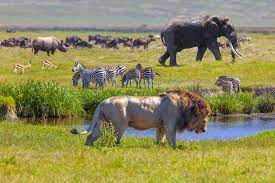Living Planet Report 2022:

According to Living Planet Report 2022, Wildlife populations decline by 69% in 50 years.
- The highest decline (94 per cent) was in the Latin America and the Caribbean region.
- Africa recorded a 66 per cent fall in its wildlife populations from 1970-2018 and the Asia Pacific 55 per cent.
- Freshwater species populations globally reduced by 83 per cent. Habitat loss and barriers to migration routes were responsible for about half of the threats to monitored migratory fish species.
- It identified six key threats to biodiversity — agriculture, hunting, logging, pollution, invasive species and climate change — to highlight ‘threat hotspots’ for terrestrial vertebrates.
- Mangroves continue to be lost to aquaculture, agriculture and coastal development at a rate of 0.13 per cent per year.
- Around 137 square kilometres of the Sundarbans mangrove forest in India and Bangladesh has been eroded since 1985.
Living Planet Report:
- It is published biennially by World Wide Fund for Nature (WWF).
- It is a comprehensive study of trends in global biodiversity and the health of the planet.
- The Living Planet Report 2022 is the 14th edition of the report.




